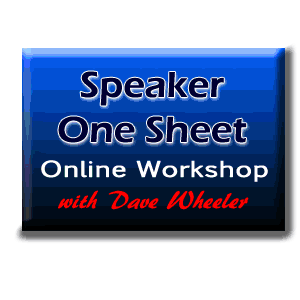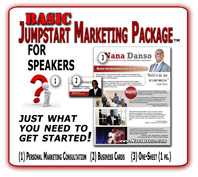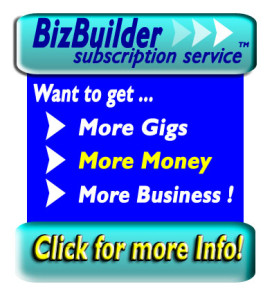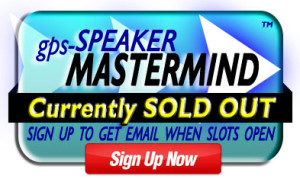Feb 15
21
Best Video Camera for Speakers
 If you are looking to choose the best video camera for speakers so you can record your speeches for later review or maybe even use the video as part of your speaker demo reel, this article covers some of the things you need to consider.
If you are looking to choose the best video camera for speakers so you can record your speeches for later review or maybe even use the video as part of your speaker demo reel, this article covers some of the things you need to consider.
The suggestions below are based on the product research I did before I purchased my own equipment as well as the experience I have gained over the years taping speakers on a regular basis and consulting with them to help set up their own capacity to videotape their speeches. Bottom line, every speaker should videotape EVERY SPEECH. You never know when you will improvise on stage and come up with a new twist on your delivery or a particular phrase that really resonates with your audience. You don’t want to miss any moment that you are on stage.
The Best Video Camera for a Speaker …
In terms of camera (or video system), this is what I suggest…
1) Must record HD. This is kinda obvious, but it had to be said,
2) external microphone input on the camera. This is needed if you go the wireless mic route or want to add a “shotgun mic” later.
3) good light sensitivity because many stages for speakers do not have great lighting.
4) capacity to record a minimum of 1 hour of continuous video. Some Digital SLR (DSLR) cameras only shoot around 20 minutes of HD before you have to hit “Record” again which can cause loads of problems if you want to just set it up and let the camera run to the end of your speech. This is also related to the amount of digital memory the camera has or is capable of using. The minimum memory for keynote speakers that I use is 64GB.
5) Other considerations include …
- Price (you can find a good video camera for speakers under $500),
- Size (keep in mind that you want something that is easy to take to every gig without too much fuss),
- Accessories (external mic’s, lens hood, extra batteries… these are what I have.)
Some more ideas regarding good audio…
If there is any question about the quality of the audio going into the camera (perhaps due to the distance of the camera from the speaker), I also record the speaker using a lapel mic into a small digital recorder with high quality sound. I can then sync this recording with the audio that was recorded in the camera using my video editing software. That usually means spending over $100 for one of the better small digital recorders. The lapel microphones can be rather cheap as long as they capture sound well. The one I use the most is an “omnidirectional mic” and was actually from Radio Shack for under $50. It captures the speaker’s voice very well and has the added benefit of capturing the audience’s reactions (applause, laughter, etc.).
ABC’s of audio for speakers on video:
a) Always carry extra batteries for your lapel mic (usually watch batteries) and your audio recorder (AAA?).
b) Be sure to test them before your speech by recording a quick “Test, One, Two, Test” and playing it back. Nothing worse than giving a great speech and then finding out you did not get good audio.
c) Choose a recorder with a “hold” button. My recorder’s “hold” button is set up so that I can push the Record button, hit the HOLD switch and none of the other buttons can be pushed until the HOLD switch is turned off.
A clip for the recorder is also a good idea, although I do not have one. (I end up sticking it into a pocket or waistband of the speaker.)
One last “thing you need”…
A full size tripod is another important videotaping tool since you don’t want the motion of the camera to be an issue. The best video camera in the world won’t be much good if the camera is hand held … and the person shakes with laughter with every joke you tell from the stage.
What if the “Best Video Camera for Speakers” means hiring a professional …
There are many times when you want better quality video of your speeches. Perhaps the crowd is large and you want to capture their reactions while also getting videotape of your speech. That requires multiple cameras and a video professional should be able to supply the necessary equipment. There is also the issue of operating multiple cameras, especially if one or more of the cameras are going to follow you on the stage or get reactions from the crowd. Being able to pan smoothly across a stage or crowd while keeping the frame centered properly is a skill that professional videographers develop over years behind a camera.
Another thing to consider is that often the person who videotapes can also edit all the raw video from an event into a speaker demo reel for you or even create a professional looking “sample presentation” which you can provide to planners looking to hire you for future gigs.
I hope this article about finding the Best Video Camera for Speakers was of help to you. Please leave a comment below if you have more questions or ideas for other things we should write about here at www.gps-SpeakerMarketing.com. Would you be interested in an article about “How to Use your Smart Phone to videotape your speech?”
Posted in Speaker Marketing 101 Video Video Equipment YouTube by .
Aug 14
2
Webcam Secrets for Speakers
As a speaker, you will inevitably be part of a video conference via Google Hangouts or maybe Skype or even as part of a webinar that you are hosting and it is important to look your best. When the webcam is on, you are ON STAGE and there are some important webcam secrets that you should be aware of.
What does the camera see?
First, you need to look your best so, men, make sure you have shaved, cleaned up as if you are going on stage, because you are. Ladies, you might not need to shave but I’m sure there are many other things you need to do if you are going to make yourself “presentable”.
Second, don’t forget your clothing. The webcam might only see your top half but you will want to wear pants too. Why? Because if you are wearing a tie with shorts, there will come a time when you will need to stand up to get a document or turn something off. Plus, you will feel more professional when you are fully clothed !
Speaking of clothing, you will come off better if you have solid colors instead of noisy patterns. The actual colors and what them mean would take another whole article to explain so you might want to sign up for our email list so you will be notified when it comes out!
Finally, consider your background. Most webcam programs will show you what you look like on camera so you should consider where you are sitting and what is behind you. If your dirty laundry is spread out behind you, it won’t help you sell your organizational services (or much else).
The webcam secrets in the video below expand on these ideas and offer some additional ones related to lighting.
Did these webcam secrets give you any ideas? They are the basics that you need to consider when you are using your webcam. For additional tips on these types of videos and much more, be sure to sign up for our free VIP newsletter in the right margin.
Posted in Speaker Marketing 101 Video YouTube by .
If you are sending emails as part of your Email Marketing plan, they won’t be very effective if they are not opened, right? If you want to get your emails OPENED, here is the Secret Email Formula that will blast through the clutter and noise of the marketplace and get your emails read.
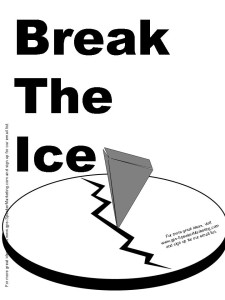 Email Marketing Secret # 1:
Email Marketing Secret # 1:
Start by Breaking Through …
The first part of your email that someone sees is the Title or Subject Line. This needs to be considered like a newspaper headline. It needs to pull in the reader so that they want to read the rest of the email. Without a strong headline, the odds are that your email is “dead in the water” and will quickly get buried under the avalanche of other emails.
What makes a strong headline?
Shorter is Better. If you can say it in 3 words instead of 5 or 7, go with the shorter headline.
Use Strong Words. If you are going to keep your headline short, each word needs to pull its weight. Use action words or words that pull in your reader. You should have a good idea about the interests of your audience, so use that information to grab their attention. In general, it is good to know that some words are particularly strong. FREE will catch the eye, but it can also get your email filtered into a spam folder. That is why you see variation on it, like “F*R-E=E”, in an attempt to get around spam filters. A better strategy would be to entice with words like “Secret”, “Formula” or “Simple”. Numbered steps are also eyecatching since they can take a generic topic like “motivation” and turn it into something that at least feels more specific, like “The 3 M’s of Motivation” or “The 5 Simple Steps to Success.” “How to” is another good title booster.
Unexpected or Unknown. If you are going to reveal a “secret”, then it is more likely that someone would read a little further. Your headline should hint at what you are going to tell the reader without giving them the full answer. Ideally, your headline creates a question in the reader’s mind such that they HAVE TO read your email.
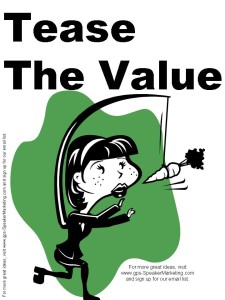 Email Marketing Secret # 2:
Email Marketing Secret # 2:
Tease First.
Providing Real Value is very important but it is even more important that you motivate your reader so that they REALLY want the information. The Tease can be as simple as a question like, “What would you do if you had a key that opened any door?” or “How much more money could you make if you increased the percentage of people who open the emails you send?” It doesn’t take much. Maybe a sentence or two at the most but it can make a world of difference in the reception that you get with the information you are providing.
Tip of the Hat to “Top Teaser” and World Champion of Public Speaking, Craig Valentine who talks more about this idea as part of his story telling and keynote development programs. For more information, check out Craig’s website at www.CraigValentine.com and be sure to sign up for his 52 Speaking Tips email list !
 Email Marketing Secret # 3:
Email Marketing Secret # 3:
Give Real Value.
This is where you give your reader the valuable content that you promised them in your title and your teaser. The value can be in the form of data about your industry, a better way to market your product or service or whatever your reader needs. You know your reader better than anyone so be sure you give them something of real value.
3 Examples of Value. One of the best types of value is a story. There are at least two types of value that can come out of a story, a lesson or entertainment, or possibly a combination of both. Pure information or data can be valuable if it relates to a problem your reader has, or could encounter. If you solve a problem for your reader and give them a tool or idea that they can use, then that provides value as well.
Don’t skimp on the value. It is better to give away some or even all of your best stuff since that is what your potential customer will use to determine if they want to do business with you. Plus, your best stuff today will be superceded by the even better stuff you are coming up with in the future. Plus, the same great stuff, when presented in person, takes on additional value so don’t worry about giving great value as part of your email marketing efforts.
Want more ideas for creating great content? Check out our List Building articles, starting with this one on “Creating Great Content”, or join our List Building email List (see below) and get loads of ideas that will help you with your email marketing.
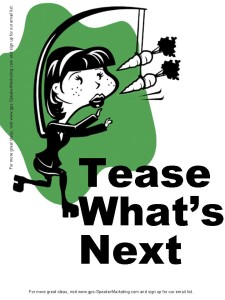 Email Marketing Secret # 4:
Email Marketing Secret # 4:
Tease What’s Next.
You have teased the value, given the value so now is the time to tease one more time… for what will come next. You have your reader excited about what you have provided, they are satisfied that you have fulfilled the promise you made with the first tease and they are ready to be engaged to follow you to the next place you are going.
But don’t leave them hangin’. Always have an idea of where you are going with your few emails. If you happen to divert from the plan and no one sends you an email asking about the tease from your last email, then maybe your tease wasn’t all that much of a draw for your reader. Plus, you can keep a “story arc” going across multiple emails that will get your reader to open each one to find out what happens next. It could be the exploits of a dog that you are fostering or just adopted or your child’s first steps or a project that you are working on in your business. It could be nearly anything where there is “action”, “challenges arise” that “you then solve”, which “leads to new challenges”. (That’s storytelling in a very small nutshell.) As a speaker, this idea should be right up your alley !
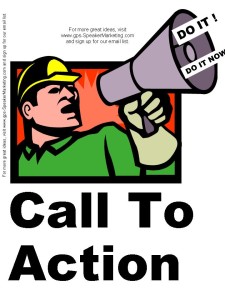 Email Marketing Secret # 5:
Email Marketing Secret # 5:
Call To Action.
You have drawn in your reader with a great headline / title, you have teased them to get them motivated to read your email, you have provided real value in your email (or a link to the full article) and you have teased them about “Coming Attractions”, so what is left?
The Call To Action. Every email or marketing piece needs one, even if it is as simple as “look for my next email”. Email marketing is the process of moving your reader along the spectrum from interested visitor to your website to fan of your ideas to purchaser of your products / services and each step requires some sort of action by the reader.
Do It. Do It NOW !
Your reader is as motivated as they will ever be to take action and NOW is the time that you ask them to do something. It can be as simple as signing up for your email list (if they are reading your article on your blog or website) or asking them to post a comment or give you feedback.
Ask Nicely. The fact that your reader is motivated to act doesn’t give you the license to ask them for too much or something unrelated. You should also phrase your request in the form of “doing you a favor” or a suggestion. Something like, “If you liked this article, please leave a comment below.” or “I’ve got a List Building program I’m developing so if you might be interested, please sign up for my List Building email list and I will let you know when it will be launched.”
Email Marketing: Bottom Line
This is only the beginning. Email marketing is a huge topic and this article, while we hope you found it useful, is only scratching the surface of what is possible. I am in the process of creating a full Email Marketing / List Building program and from time to time will be publishing parts of it, such as this article on “Creating Great Content”. So if you found this article helpful, you probably will want to join our List Building email List (see below) and I will be sure to send you even more ideas that will help you grow your speaking business with through email marketing.



